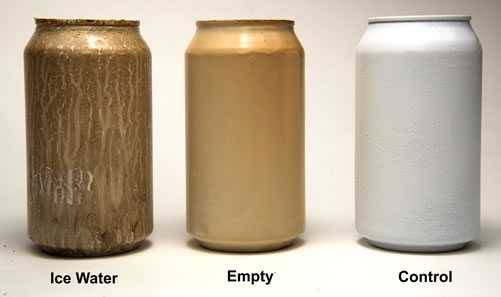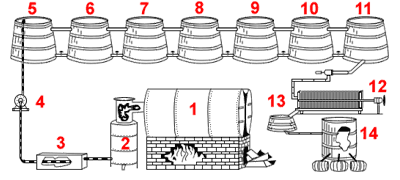Most barbecue sauces contain liquid smoke or “Natural smoke flavor”, and some commercial meats, like hams, jerkies, and sausages are created with liquid smoke. Barbecue purists (snobs?) detest the concept, but I see it as just another flavoring in my arsenal. Because I have several smokers, I rarely need it, but if you live in a hi-rise or a dorm, it can bring some of the outdoor flavor indoors as we did in our indoor ribs recipe.
If you are among the haters, please note that it is made by a distillation process similar to making whiskey, so back away from the bar and put down that single malt, pahdna. In fact, it is made in a similar manner to making barbecue!
As shown in the illustration from Colgin, hardwood sawdust or chips are heated in a tank until they smolder but not burn (1). The gases and particles are cooled so that they condense and liquefy usually with the help of water (2 – 3). It is then refined (5 – 11) and filtered (12) to remove impurities, and then aged in oak barrels (14). This is, in fact, similar to the way smoke flavors food. It condenses on the food which is cooler than the smoke. You can read more about the process in my article on wood and smoke.

Above are three beer cans I painted white. The one on the left was filled with ice water and the middle one was empty. They both went into a smoker for about an hour. The one on the right sat on my desk. As you can see, smoke is attracted to cool surfaces, a process called thermophoresis.
I asked the AmazingRibs.com science advisor Prof. Greg Blonder to describe the differences between smoke vapors and liquid smoke. He said “Wood combustion smoke contains hundreds of chemical compounds. A few with sweet pronounced caramel notes, others smoky and clean like an autumn campfire, but many are bitter and acrid. Some are carcinogenic and others antibacterial and others act as a preservative. Most of the smoke is in the form of gases that cannot be captured and bottled in liquid form, or rapidly degrade into flavorless molecules. Enough stable smoke compounds are either water or oil soluble and they can be condensed, filtered, and washed out of the smoke and then sold by the bottle.
“Liquid smoke, at least the better grades, is designed to minimize bitter flavors and known carcinogenic compounds, while maximizing smoke-like flavor and color. Because liquid smoke contains only a subset of all the combustion products produced in a wood fire, and in different proportions, the bottled flavor is not a perfect reproduction of a fire pit. However, combined with herbs, spices, sauces, and even charred veggies, the results can be close to real barbecue.”
Liquid smoke is quite strong and if you wish to use it in a sauce or slow cooker, add just a few drops at a time. There are two major brands, Colgin and Wright’s. Colgin adds water, vinegar, molasses, caramel coloring, and salt. Wright’s adds only water to most of its flavors, but the applewood flavor also contains apple and maple flavors. There are noticeable taste differences between them, and we slightly prefer Wright’s. Can you tell the difference between foods flavored with liquid smoke and with vaporous smoke? Yes. But I’ll bet there are people who prefer the liquid smoke! Here’s a link to the different liquid smokes on Amazon.



High quality websites are expensive to run. If you help us, we’ll pay you back bigtime with an ad-free experience and a lot of freebies!
Millions come to AmazingRibs.com every month for high quality tested recipes, tips on technique, science, mythbusting, product reviews, and inspiration. But it is expensive to run a website with more than 2,000 pages and we don’t have a big corporate partner to subsidize us.
Our most important source of sustenance is people who join our Pitmaster Club. But please don’t think of it as a donation. Members get MANY great benefits. We block all third-party ads, we give members free ebooks, magazines, interviews, webinars, more recipes, a monthly sweepstakes with prizes worth up to $2,000, discounts on products, and best of all a community of like-minded cooks free of flame wars. Click below to see all the benefits, take a free 30 day trial, and help keep this site alive.
Post comments and questions below
1) Please try the search box at the top of every page before you ask for help.
2) Try to post your question to the appropriate page.
3) Tell us everything we need to know to help such as the type of cooker and thermometer. Dial thermometers are often off by as much as 50°F so if you are not using a good digital thermometer we probably can’t help you with time and temp questions. Please read this article about thermometers.
4) If you are a member of the Pitmaster Club, your comments login is probably different.
5) Posts with links in them may not appear immediately.
Moderators